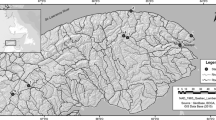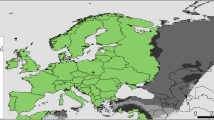Abstract
The building of knowledge about current risks from changes in air temperature has been established as critical for informing the starting point for human health risk assessments in a climate-changing world. The study presented in this paper provides the application of the maximum/minimum temperature complex method in Colombia to identify the simultaneous behavior of daily extremes of air temperature and provide a tool to assess human health risks due to temperature variability. An established classification of mean temperatures exists for the country, and maximum and minimum temperatures have been studied but never as simultaneous variables. The max/min temperature complex analysis aims to describe the air temperature regime of a particular place by studying the frequency of simultaneous occurrence of extreme daily temperatures. The study consisted of the construction of a contingency table that combines the behavior of the daily maximum and minimum temperatures using a subdivision of 5 °C intervals. A 5-year (2010–2015)-long dataset of 171 weather stations from the entire territory was prepared by identifying, filtering, and completing the missing data. Frequencies of occurrence of each interval were arranged in descending order to select the intervals of frequencies above 10%. Then, they were classified into categories, types, and subtypes. Six categories, seven types, and fifty-one subtypes were identified and mapped to ascertain their geographical distribution. In contrast with other climate regime classifications, our study found a regionalization of daily extremes of temperature that can be analyzed in different scales of time and space to aid health risk analysis.







Similar content being viewed by others
Notes
The complex term in this context refers to the school of complex climatology defined by E.E Fedorov (Lydolph 1959) in the Soviet Union and called “complex” because it works with the representation of index and parameters form by two or more independent variables which interactions are categorized by symbols.
The use of 5 °C intervals corresponds with the general statistical structure of the air temperature in the humid tropics. Due to the small variation of the daily maximum and minimum temperatures, the data dispersion on a dataset of temperatures from weather station in different locations and altitudes through time is small. Since the majority of temperature data concentrates around the mean value, the entire range of the data series can be divided into small intervals that result in a detailed categorizations of the data analyzed. In the case of the dataset evaluated for this study, the smallest minimum temperature found was − 10 °C and the greatest 30 °C. For the maximum daily temperatures, the smallest number found is 5 °C and the greatest 45 °C. Since the intervals of the extremes of the histogram are the less frequent, the cuts made for the contingency table correspond to the general statistical structure of the air temperature of Colombia.
References
Akbari H, Cartali C, Kolokotsa D, Muscio A, Pisello A, Rossi F, Santamouris M, Synnefa A, Wong N, Zinizi M (2016) Local climate change and urban heat island. Mitigation techniques-the state of the art Journal of Civil Engineering and Management 22:1–16
Arango-Aramburo S, Turner S, Daenzer K, Ríos-Campo J, Hejazi M, Kober T, Álvarez-Espinosa A, Romero-Otálora G, van der Zwaan B (2019) Climate impacts on hydropower in Colombia: a multi-model assessment of power sector adaptation pathways. Energy Policy 15. https://doi.org/10.1186/s12940-016-0102-7
Arbuthnott K, Hajat S, Heaviside C, Vardoulakis S (2016) Changes in population susceptibility to heat and cold over time: assessing adaptation to climate change. Environ Health 15. https://doi.org/10.1186/s12940-016-0102-7
Barón A (2003) Geospatial models of climatological variables distribution over Colombian territory. Meteorologia Colombiana 7:81–89
Burkart K, Khan MH, Schneider A, Breitner S, Langner M, Krämer A, Endlicher W (2014) The effects of season and meteorology on human mortality in tropical climates: a systematic review. Trans R Soc Trop Med Hyg 108:393–401. https://doi.org/10.1093/trstmh/tru055
Cordovez J, Rendon L, Gonzales C, Guhl F (2014) Using the basic reproduction numbers to assess the effects of climate change in the risk of Chagas disease transmission in Colombia. Acta Trop 129:74–82. https://doi.org/10.1016/j.actatropica.2013.10.003
Correal ME, Marthá JE, Sarmiento R (2015) Influencia de la variabilidad climática sobre las enfermedades respiratorias agudas en la ciudad de Bogotá. In: Influencia de la variabilidad climática en las enfermedades respiratorias agudas en Bogotá. Biomédica. https://doi.org/10.7705/biomedica.v35i0.2456
Environmental Systems Research Institute, Inc. (2010) ArcGIS (GIS software) version 10.0. https://www.esri.com
Eslava J (1992) Perfil altitudinal de la temperatura media del aire en Colombia. Earth Sciences Research Journal 1:37–52 https://revistas.unal.edu.co/index.php/esrj/article/view/31200.
Gonzales C, Paz A, Ferro C (2014) Predicted altitudinal shifts and reduced spatial distribution of Leishmania infantum vector species under climate change scenarios in Colombia. Acta Trop 129:83–90. https://doi.org/10.1016/j.actatropica.2013.08.014
Green H, Bailey J, Schwarz L, Vanos J, Ebi K (2019) Impact of heat on mortality and morbidity in low and middle-income countries: a review of the epidemiological evidence and considerations for future research. Environ Res 171:80–91. https://doi.org/10.1016/j.envres.2019.01.010
Hajat S, Kosatky T (2010)Heat-related mortality: a review and exploration of heterogeneity. J Epidemiol Community Health 64:753–760. https://doi.org/10.1136/jech.2009.087999
Lecha L (1998) Biometeorological classification of daily weather types for humid tropics. Int J Biometeorol 42:77–83
Lecha L, Florido A (1989) Tipificación del regimen termico del aire en Cuba. Revista Cubana de Meteorologia 1(2):34–41
Lecha L, Nourzhanova M (1990) Descripción preliminary del clima de Nicaragua según los estados del tiempo diarios. Revista Cubana de Meteorologia 3:53–61
Lee W, Bell MI, Gasparrini A, Armstrong BG, Sera F, Hwang S et al (2018) Mortality burden of diurnal temperature range and its temporal changes: a multi-country study. Environ Int 110:123–130. https://doi.org/10.1016/j.envint.2017.10.018
Llinás R (2013) Delimitación de las regiones naturales de Colombia. Sociedad Geográfica de Colombia, Bogotá
Lyndolph PE (1959) Fedorov’s complex method in climatology. Ann Assoc Am Geogr 49:120–144. https://doi.org/10.1111/j.1467-8306.1959.tb01604.x
Martin D, Lecha L (2012) La variabilidad espacio-temporal del régimen térmico en España como fundamento para evaluar los efectos potenciales del estado del tiempo sobre la salud humana. Annals of the Octavo congreso de la asociación Española de Climatología (AECLIM)http://aeclim.org/wp-content/uploads/2016/02/0081_PU-SA-VIII-2012-D_MARTIN.pdf.
Narváes-Bravo G, León-Aritizabal G (2001) Caracterización y zonificación climática de la región andina. Meteorología Colombiana 4:121–126
Pabón-Caicedo J, Eslava-Ramírez J, Gómez-Torres R (2001) Generalidades de la distribución espacial y temporal de la temperatura del aire y de la precipitación en Colombia. Meteorología Colombiana 4:47–59
Pérez A (1989) Atlas y Geografía de Colombia. Círculo de lectores, Bogotá
Potchter O, Cohen P, Lin T, Matzarakis A (2018) Outdoor human thermal perception in various climates: a comprehensive review of approaches, methods and quantification. Sci Total Environ 631-632:390–406. https://doi.org/10.1016/j.scitotenv.2018.02.276
Quintero-Herrera L, Ramírez-Jaramillo V, Bernal-Gutiérrez S, Cárdenas-Giraldo E, Guerrero-Matituy E, Molina-Delgado A, Montoya-Arias C, Rico-Gallego J, Herrera-Giraldo A, Botero-Franco S, Rodriguez-Morales A (2015) Potential impact of climatic variability on the epidemiology of dengue in Risaralda, Colombia, 2010–2011. In: Potencial impact of climatic variability on the epidemilogy of dengue in Risaralda, Colombia, 2010–2011. Journal of Infection and Public Health. https://doi.org/10.1016/j.jiph.2014.11.005
Renganathan G, Rohinton E (2018) The impact of urban compactness, comfort strategies and energy consumption on tropical urban heat island. Intensity: a review Sustainable Cities and Society 40:677–687. https://doi.org/10.1016/j.scs.2018.01.024
Roth M (2007) Review of urban climate research in (sub) tropical regions. Int J Climatol 27:1859–1873
Roth M, Jansson C, Velasco E (2017)Multi-year energy balance and carbon dioxide fluxes over residential neighborhood in a tropical city. Int J Climatol 37:2679–2698
Ruiz D, Moreno H, Gutiérrez M, Zapata P (2008) Changing climate and endangered high mountain ecosystems in Colombia. Sci Total Environ 398:122–132. https://doi.org/10.1016/j.scitotenv.2008.02.038
Santos AR et al (2015) Espacialização de Dados Meteorológicos no ArcGIS 10.3 Passo a Passo. CAUFES, Alegre
Sharovsky R, Machado César LA (2002) Increase in mortality due to myocardial infarction in the Brazilian city of São Paulo during winter. Arq Bras Cardiol 78(1):106–109
Stocker T, Qin DG, Plattner K, Tignor M, Allen SK, Boschung J et al (2013) The physical science basis: contributions of working group I to the fifth assessment report of the intergovernmental panel on climate change. In IPCC, pp:1–30
Watts Adger W, Agnolucci P, Blackstock J, Byass P, Cai W et al (2015) Health and climate change: policy responses to protect public health. Lancet. 386:1861–1914. https://doi.org/10.1016/S0140-6736(15)60854-6
Ye Y, Zulu E, Mutisya M et al (2009) Seasonal pattern of pneumonia mortality among under-five children in Nairobi’s informal settlements. Am J Trop Med Hyg 81:770–775
Acknowledgments
We would like to thank the Administrative Department of Science, Technology and Innovation of Colombia (COLCIENCIAS) for providing the opportunity for this research with its doctoral graduates’ overseas program.
Author information
Authors and Affiliations
Corresponding author
Ethics declarations
Conflict of interest
The authors declare that they have no conflicts of interest.
Ethics, consent and permissions
Not applicable.
Additional information
Publisher's note
Springer Nature remains neutral with regard to jurisdictional claims in published maps and institutional affiliations.
Rights and permissions
About this article
Cite this article
Roncancio, D.J., Lecha, L. & Nardocci, A. Classification of daily weather types in Colombia: a tool to evaluate human health risks due to temperature variability. Int J Biometeorol 64, 1795–1806 (2020). https://doi.org/10.1007/s00484-020-01963-4
Received:
Revised:
Accepted:
Published:
Issue Date:
DOI: https://doi.org/10.1007/s00484-020-01963-4




